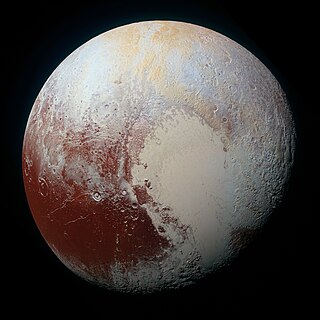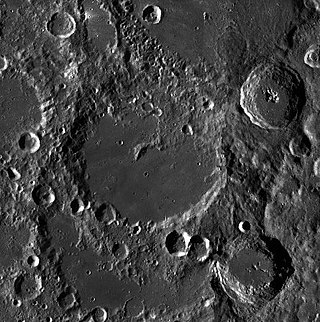Craters
Rhean craters are named after figures from the mythologies of mostly non-European cultures. As of 2017, there are 128 named craters. [3]
This is a list of named geological features on Rhea, the second largest moon of Saturn. [1] Planetary features are approved by the International Astronomical Union's (IAU) Working Group for Planetary System Nomenclature (WGPSN). [2]
A catena /kəˈtiːnə/ is a crater chain.
| Name | Coordinates | Diameter (km) | Approval Date | Named After | Notes | Ref |
|---|---|---|---|---|---|---|
| Koykamou Catena | 70°S244°W / 70°S 244°W | 110 | 6 August 2010 | Koykamou, a mountain in Nganasan mythology | — | WGPSN |
| Mouru Catena | 48°30′N343°30′W / 48.5°N 343.5°W | 80 | 6 August 2010 | Merv, holy land in Persian mythology | — | WGPSN |
| Onokoro Catenae | 44°42′S328°30′W / 44.7°S 328.5°W | 240 | 6 August 2010 | Onokoro, mythical island in Japanese mythology | — | WGPSN |
| Puchou Catenae | 32°N87°W / 32°N 87°W | 620 | 6 August 2010 | Pu Chou Mountain in Chinese mythology | Formerly classified as a chasma | WGPSN |
| Thebeksan Catena | 39°30′S174°00′W / 39.5°S 174°W | 220 | 6 August 2010 | Thebeksan, holy mountain in Korean mythology | — | WGPSN |
| Wungaran Catenae | 22°30′N79°00′W / 22.5°N 79°W | 350 | 6 August 2010 | Wungaran, sacred place in Kakadu, Australia | — | WGPSN |
Rhean chasms are called chasmata. They are named after sacred places in world mythologies.
| Chasma | Named after |
|---|---|
| Avaiki Chasmata | Avaiki, the underworld in Cook Islands mythology |
| Galunlati Chasmata | ᎦᎸᎳᏗ galvladi (galvv́ládii) "the above": the land above the sky in Cherokee mythology |
| Kun Lun Chasma was reclassified as a linea in 2010 (see below) | |
| Pu Chou Chasma was reclassified as a catena in 2010 (see above) | |
| Pulag Chasma | Pulag, sacred mountain in Igorot mythology |
| Vaupas Chasma | Vaupas, a river in the mythology of the Cuebo of Colombia |
| Yamsi Chasmata | Yamsi, lodge of the North Wind in Klamath mythology |
Rhean craters are named after figures from the mythologies of mostly non-European cultures. As of 2017, there are 128 named craters. [3]
A fossa is a long, narrow depression.
| Name | Coordinates | Diameter (km) | Approval Date | Named After | Ref |
|---|---|---|---|---|---|
| Harahvaiti Fossa | 36°S171°W / 36°S 171°W | 190 | 6 August 2010 | Beautiful land created by Persian god Ahura Mazda; modern Kandahar, Afghanistan | WGPSN |
| Parun Fossa | 46°30′S152°00′W / 46.5°S 152°W | 120 | 6 August 2010 | Parun River, Nuristan (NE Afghanistan), in which the mother goddess Disani gave birth to Bagisht, the creator of people | WGPSN |
A linea is a long marking on a planet or moon's surface.
| Name | Coordinates | Diameter (km) | Approval Date | Named After | Notes | Ref |
|---|---|---|---|---|---|---|
| Kirinyaga Linea | 1°48′S128°48′W / 1.8°S 128.8°W | 400 | 17 June 2010 | Mount Kenya (Kirinyaga), a holy mountain in Kikuyu mythology. | — | WGPSN |
| Kunlun Linea | 45°N308°W / 45°N 308°W | 180 | 6 August 2010 | Kunlun Mountains, home of the gods in Chinese mythology | Formerly classified as a chasma | WGPSN |

Planetary nomenclature, like terrestrial nomenclature, is a system of uniquely identifying features on the surface of a planet or natural satellite so that the features can be easily located, described, and discussed. Since the invention of the telescope, astronomers have given names to the surface features they have discerned, especially on the Moon and Mars. To found an authority on planetary nomenclature, the International Astronomical Union (IAU) was organized in 1919 to designate and standardize names for features on Solar System bodies.

Von Kármán is a large lunar impact crater that is located in the southern hemisphere on the far side of the Moon. The crater is about 186 km (116 mi) in diameter and lies within an immense impact crater known as the South Pole–Aitken basin of roughly 2,500 km (1,600 mi) in diameter and 13 km (8.1 mi) deep. Von Kármán is the site of the first soft-landing on the lunar far side by the Chinese Chang'e 4 spacecraft on 3 January 2019.

Patsaev is a lunar impact crater that lies on the far side of the Moon, to the northeast of the prominent crater Tsiolkovskiy. To the northwest is the smaller crater Lander.
Stokes is an impact crater on Mars, located on the Martian Northern plains at 55.9°N latitude and 188.8°W longitude. It measures approximately 62.74 kilometres (38.98 mi) in diameter and was named after Irish-born physicist George Gabriel Stokes (1819–1903). The crater's name was officially adopted by IAU's Working Group for Planetary System Nomenclature in 1973.
The Mindolluin Montes are a range of mountains on Titan, the largest moon of the planet Saturn. The range is located near Titan's equator, between 1–4° south and 205–213° east. It is located within the Adiri region, just west of the landing site of the Huygens probe.
The Taniquetil Montes are a mountain range on Titan, the largest moon of the planet Saturn. The range is located near Titan's equator, between 2° and 4° south, and 211° and 214° west. It is located within the Adiri region, just west of the landing site of the Huygens probe.

Mons is a mountain on a celestial body. The term is used in planetary nomenclature: it is a part of the international names of such features. It is capitalized and usually stands after the proper given name, but stands before it in the case of lunar mountains.
Agnesi is a crater on the planet Venus. It was named after Maria Gaetana Agnesi, an Italian mathematician; Venusian craters are named after notable women. The crater was named by the International Astronomical Union's Working Group on Planetary System Nomenclature in 1991. It is located at 39.4 degrees south and 37.7 degrees east. The crater is 42.4 kilometers in diameter.

PateraPAT-ər-ə is an irregular crater, or a complex crater with scalloped edges on a celestial body. Paterae can have any origin, although the majority of them were created by volcanism. The term comes from Latin, where it refers to a shallow bowl used in antique cultures.